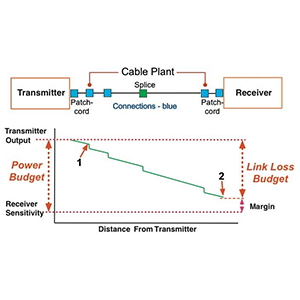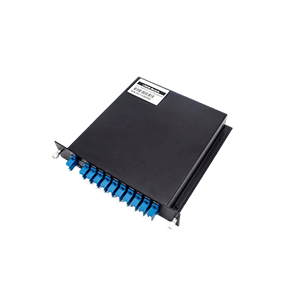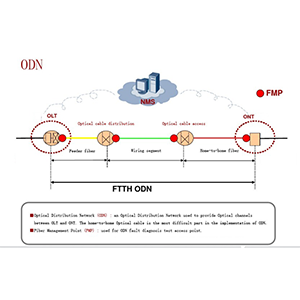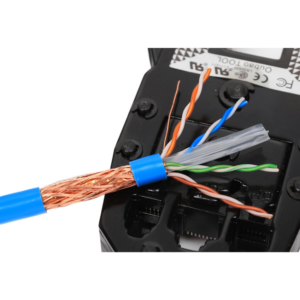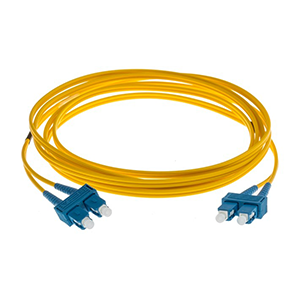As a key component in fiber optic communications, fiber optic multiplexers play an important role in achieving efficient fiber optic transmission. This article explains what fiber optic multiplexers are, how they work, and the different types and technologies. We will also explore the application of fiber optic multiplexers in the fields of optical communication networks and telecom operators, as well as their cooperation with other network equipment. In addition, the installation and maintenance precautions of optical fiber multiplexers are provided, and the future development trend of optical fiber multiplexers is prospected.
Introduction to fiber optic multiplexers
Definition and functions:
Optical Fiber Multiplexer is a device used for multiplexed optical fiber transmission. Its basic function is to combine multiple signals or channels into one optical fiber for transmission, or to demultiplex multiple signals or channels from an optical fiber. Optical fiber multiplexers can improve fiber utilization, reduce the number and cost of optical fibers, and enable high-bandwidth data transmission.
The main functions of fiber optic multiplexers include:
-
Multiplexing: Fiber optic multiplexers can combine multiple signals or channels into one optical fiber for transmission. This means that multiple data streams can be transmitted simultaneously through the same optical fiber, improving the transmission efficiency of the optical fiber.
-
Demultiplexing: Fiber optic multiplexers can demultiplex multiple signals or channels from optical fibers. It separates different signals or channels for separate processing or transmission in the target device or system.
-
Increase bandwidth: Through the multiplexing function of the optical fiber multiplexer, multiple signals or channels can be combined into one optical fiber, thus increasing the transmission bandwidth. This is important for applications with high bandwidth requirements, such as data center interconnects, WAN transmission, and video transmission.
working principle:
The working principle of fiber optic multiplexers mainly involves two technologies: Wavelength Division Multiplexing (WDM) and Dense Wavelength Division Multiplexing (DWDM).
-
Wavelength division multiplexing (WDM): Wavelength division multiplexing uses different optical wavelengths to combine multiple signals or channels into one optical fiber for transmission. Each signal or channel uses a different wavelength and does not interfere with each other in the fiber. At the receiving end, the fiber multiplexer demultiplexes individual signals or channels by separating different wavelengths.
-
Dense wavelength division multiplexing (DWDM): Dense wavelength division multiplexing is a more efficient wavelength division multiplexing technology that uses denser wavelength intervals to multiplex more signals or channels. DWDM technology uses tighter wavelength spacing, typically at the nanometer level, to enable the multiplexing of dozens or even hundreds of signals or channels. This can significantly increase the transmission capacity of optical fiber.
In an optical fiber multiplexer, the wavelength division multiplexing or DWDM module is responsible for combining different signals or channels into one optical fiber, while the demultiplexing module is responsible for separating these signals or channels from the optical fiber. These modules usually use optical components such as gratings, optical filters, and optical beam splitters to achieve multiplexing and demultiplexing functions.
Through wavelength division multiplexing and DWDM technology, fiber multiplexers can achieve efficient fiber transmission, providing larger bandwidth and more flexible data transmission solutions.
Types and technologies of fiber optic multiplexers
Wavelength multiplexing (WDM):
Wavelength Division Multiplexing (WDM) is a common optical fiber multiplexing technology that uses different optical wavelengths to combine multiple signals or channels into one optical fiber for transmission. In fiber optic multiplexers, wavelength division multiplexing technology is usually implemented through the use of optical components such as gratings, optical filters, and optical beam splitters.
Applications of wavelength division multiplexing technology in optical fiber multiplexers include:
-
CWDM (Coarse Wavelength Division Multiplexing): Coarse wavelength division multiplexing technology uses wider wavelength intervals, usually at the level of several nanometers, to achieve the multiplexing of relatively few signals or channels. CWDM is generally suitable for lower demand applications such as LAN interconnection, fiber-to-the-home (FTTH), etc.
-
DWDM (Dense Wavelength Division Multiplexing): Dense wavelength division multiplexing technology uses more compact wavelength intervals, usually at the level of tens to hundreds of megananometers, to achieve the multiplexing of more signals or channels. DWDM technology is suitable for high-capacity optical fiber transmission, such as optical fiber backbone networks, long-distance transmission and data center interconnection.
Dense Wavelength Division Multiplexing (DWDM):
Dense Wavelength Division Multiplexing (DWDM) is a high-capacity wavelength division multiplexing technology that uses denser wavelength intervals to multiplex more signals or channels. Compared with traditional wavelength division multiplexing technology, DWDM technology can multiplex dozens or even hundreds of signals or channels in optical fibers.
The applications of DWDM technology in high-capacity optical fiber transmission include:
-
Optical fiber backbone network: DWDM technology is widely used in optical fiber backbone networks to meet large-capacity, long-distance transmission requirements. It can significantly increase the transmission capacity of optical fiber networks and support high-speed data, voice and video transmission.
-
Data center interconnection: Data centers have increasingly higher requirements for high-bandwidth, low-latency connections. DWDM technology can provide high-density optical fiber connections and support fast data transmission between large-scale data centers.
-
Long-distance transmission: The high capacity and signal multiplexing capabilities of DWDM technology make it an ideal choice for long-distance transmission. It can effectively increase the optical fiber transmission distance and reduce the number of optical fibers and equipment costs.
-
Video distribution: DWDM technology can be used in high-capacity video distribution networks, such as radio, television and streaming media. It can transmit multiple high-definition video signals simultaneously to meet the transmission needs of multimedia content.
It should be noted that the application of WDM and DWDM technology in optical fiber multiplexers can be selected according to specific needs and network size. For lower capacity and shorter distance requirements, CWDM and traditional WDM technologies may be more suitable; while for high capacity and long-distance transmission requirements, DWDM technology is more suitable.
Application fields of optical fiber multiplexers
Optical communication network:
-
Long-distance transmission: Optical fiber multiplexers can combine multiple signals or channels into one optical fiber through wavelength division multiplexing technology (such as WDM and DWDM) to achieve high-capacity long-distance transmission. This is important for fiber optic backbone networks and fiber optic transmission across continents or internationally.
-
Data center interconnection: Data centers require high-bandwidth and low-latency connections to support the transmission and processing of large-scale data. Optical fiber multiplexers can provide high-density optical fiber connections, combining signals or channels between multiple data centers into one optical fiber to achieve high-speed, high-capacity data center interconnection.
-
Fiber to the home (FTTH): Fiber optic multiplexers are used in FTTH networks to combine the signals or channels of multiple users into one optical fiber for transmission. This enables high-speed broadband access to meet the needs of home and business users for high-speed Internet and multimedia services.
Telecom operators:
Fiber optic multiplexers are also widely used in telecom operator networks. Here are some common usage scenarios:
-
Fiber optic backbone network: Telecom operators usually build fiber optic backbone networks to realize data transmission between different regions. Fiber optic multiplexers can use wavelength division multiplexing technology in fiber optic backbone networks to provide high-capacity and efficient data transmission to meet the growing demand for data communications.
-
Wireless communication base stations: Telecom operators’ wireless communication base stations require reliable high-speed connections to support mobile communication services. Fiber optic multiplexers can be used to combine signals from multiple base stations into one optical fiber to achieve high-capacity, low-latency data transmission and provide better wireless network performance.
-
Internet access: Telecom operators provide Internet access services. Optical fiber multiplexers can be used to merge the Internet traffic of multiple users into one optical fiber to achieve high-speed broadband access. This provides higher bandwidth and a more reliable internet connection.
The application of optical fiber multiplexers in optical communication networks and telecom operator networks provides high-speed, high-bandwidth, and high-efficiency data transmission solutions, meeting the requirements for data transmission capacity and performance in different fields.
Performance parameters of optical fiber multiplexer
Number of channels and wavelength range:
The channel number of a fiber optic multiplexer refers to the number of signals or channels it can support simultaneously. The number of channels depends on the design and technology of the fiber multiplexer and can scale from a few channels to hundreds or more. Generally, WDM technology can realize the multiplexing of several channels, while DWDM technology can realize the multiplexing of more channels.
Wavelength range refers to the wavelength range of signals or channels supported by the fiber multiplexer. Typically, fiber multiplexers support wavelength ranges in the visible and infrared regions. For WDM technology, the wavelength of each channel is usually in the range of a few nanometers, such as 1310 nm, 1490 nm and 1550 nm. For DWDM technology, denser wavelength spacing is usually used, such as 100 GHz or 50 GHz, to achieve more channel multiplexing.
Signal transmission distance and gain attenuation characteristics:
Signal transmission distance refers to the maximum distance over which a fiber optic multiplexer can transmit signals or channels. This parameter depends on factors such as the design of the multiplexer, the fiber quality and the amplifier used. Generally, fiber optic multiplexers can achieve signal transmission distances from tens of kilometers to thousands of kilometers.
During the signal transmission process, the optical signal will experience attenuation, and the fiber multiplexer needs to provide appropriate gain during the signal transmission process to compensate for the attenuation loss. The gain attenuation characteristics of a multiplexer describe its gain and attenuation during signal transmission. Typically, fiber multiplexers are equipped with fiber amplifiers or optical amplifiers to provide signal gain to maintain signal quality and transmission distance.
It is important to note that different fiber optic multiplexers have different performance parameters, which may vary depending on the manufacturer, model and application requirements. When selecting a fiber optic multiplexer, these performance parameters need to be considered based on specific communication needs and network size, and a suitable multiplexer needs to be selected to meet the requirements.
Cooperation between fiber optic multiplexers and other network equipment
Fiber optic multiplexers often work together with other network equipment in optical communication networks, including fiber optic switches and fiber optic amplifiers.
Fiber optic switch:
Fiber optic switches are devices used for data switching and routing in fiber optic networks. It can realize switching and forwarding of optical signals, enabling flexible connections between different optical fiber links. Compared with fiber optic switches, fiber optic multiplexers focus more on the multiplexing and demultiplexing of optical signals.
Fiber optic multiplexers and fiber optic switches can be used in conjunction with each other to build more complex and flexible optical communication networks. Fiber optic multiplexers can combine multiple optical signals or channels into one optical fiber for transmission, while fiber optic switches can switch and route between different optical fiber links to achieve communication between different nodes. By combining fiber optic multiplexers with fiber optic switches, higher data transmission capacity and more flexible network connections can be achieved.
optical fiber amplifier:
A fiber optic amplifier is a device used to increase the strength of optical signals. It can provide gain of optical signals to compensate for the loss of light during transmission and extend the signal transmission distance. Fiber optic multiplexers and fiber amplifiers often work together in optical communication networks.
The cooperative working principle of the optical fiber multiplexer and the optical fiber amplifier is that at the output end of the optical fiber multiplexer, the optical signal is multiplexed and then sent to the optical fiber amplifier. Fiber optic amplifiers increase the strength of the signal and transmit it to the target location or the next fiber optic link. This can effectively compensate for the attenuation of optical signals during transmission and expand the signal transmission distance.
Fiber optic multiplexers, fiber optic switches, and fiber optic amplifiers need to be selected and configured based on specific network needs and designs. Their collaborative work can provide higher data transmission capabilities, more flexible connections, and longer transmission distances to meet communication needs in different application scenarios.
Installation and maintenance precautions for fiber optic multiplexers
The correct installation and maintenance of fiber optic multiplexers is crucial to ensure the normal operation of optical communication networks. Here are some considerations and suggestions:
Installation and connection:
-
Make sure you choose a suitable installation location: Choose a dry, well-ventilated place with a moderate temperature to install the fiber optic multiplexer. Avoid installation in an environment that is too humid, dusty or too hot.
-
Survey and plan the fiber path: Before proceeding with the installation, survey and plan the fiber path. Ensure that the fiber connections between the fiber multiplexer and other equipment are accurate, reliable, and meet design requirements.
-
Connect the fiber correctly: Before connecting the fiber, make sure the end face of the fiber is clean and flat. Use appropriate fiber optic connectors and accessories and follow correct connection procedures to ensure a stable and reliable fiber optic connection.
-
Pay attention to the bending radius of optical fiber transmission: During the installation and connection process, avoid applying excessive bends to the optical fiber to prevent loss and breakage of optical signals. Follow the minimum bending radius requirements of optical fibers to ensure normal transmission of optical fibers.
Maintenance and troubleshooting:
-
Regular inspection and cleaning: Regularly check the status of the fiber optic multiplexer to ensure its normal operation. Clean the end faces of fiber optic connectors regularly to prevent the buildup of dust, grease, or dirt from affecting signal quality.
-
Pay attention to temperature and humidity: Maintain appropriate ambient temperature and humidity to prevent excessively high or low temperature and humidity from affecting the performance of the optical fiber multiplexer. Avoid exposing fiber optic multiplexers to extreme environmental conditions.
-
Pay attention to alarm and fault indication: Fiber optic multiplexers are usually equipped with alarm and fault indication functions. Check these lights regularly to identify and resolve any potential problems promptly.
-
Maintain spare equipment and spare parts: In order to cope with possible failure situations, it is important to maintain an appropriate amount of spare equipment and spare parts. This allows faulty equipment to be quickly replaced and the network to be restored to normal operation as quickly as possible.
-
Troubleshooting Tips: If a malfunction occurs, first check whether the fiber optic connection is loose or damaged. Use optical power meters, spectrum analyzers and other tools to detect and analyze optical signals to determine the specific cause of the failure. Works with vendor or technical support team for troubleshooting as needed.
It is important to follow the installation and maintenance guidelines provided by the manufacturer of the fiber optic multiplexer. Proper operation and optimal performance of your fiber optic multiplexer can be ensured by following proper operation and maintenance procedures.
The future development trend of optical fiber multiplexers
As an important component of optical communication networks, fiber optic multiplexers will continue to develop and evolve with the advancement of technology and evolving needs. The following are the future development trends of fiber optic multiplexers:
High capacity transmission:
With cloud computing, big data, high-definition video and the Internet of Things and other applications, the demand for network transmission capacity continues to increase. Fiber optic multiplexers will evolve to support higher capacity transmission. By adopting higher-rate optical fiber multiplexing technologies, such as dense wavelength division multiplexing (DWDM) and coherent optical transmission technology, more optical channels and greater data transmission capacity can be achieved.
Network expansion:
As networks continue to expand and cover more areas, fiber optic multiplexers will play an important role in network expansion. Further developments in fiber optic multiplexers will focus on better network integration and expansion capabilities to enable larger ranges of data transmission and connectivity.
Network virtualization:
The rapid development of network virtualization and software-defined networking (SDN) has brought new application prospects for fiber optic multiplexers. By virtualizing fiber optic multiplexers, a more flexible, programmable and scalable network architecture can be achieved. The virtualization of optical fiber multiplexers can enable network operators to better manage and configure optical fiber resources and improve network efficiency and flexibility.
Intelligence and automation:
Future fiber multiplexers will tend to be more intelligent and automated. By introducing artificial intelligence (AI) and machine learning (ML) technologies, optical fiber multiplexers can better monitor and manage network performance, automatically detect and repair faults, and improve network reliability and stability.
Energy saving and environmental protection:
In future development, fiber multiplexers will pay more attention to energy saving and environmental protection. Reduce energy consumption and carbon emissions by adopting more efficient energy management and thermal management technologies to achieve more sustainable network operations.
The future development trend of optical fiber multiplexers will focus on providing higher capacity transmission, supporting network expansion and integration, applying to network virtualization and SDN, achieving intelligence and automation, and focusing on energy conservation and environmental protection. These trends will drive future evolution and innovation of fiber optic multiplexers to meet growing network demands and technical challenges.
Summarize:
As a key technology in optical fiber communications, optical fiber multiplexers provide important support for efficient optical fiber transmission. By properly selecting and configuring fiber optic multiplexers, we can achieve simultaneous transmission of multiple signals, high-capacity transmission, and long-distance transmission.
With the development of technology and the growth of demand, fiber optic multiplexers will play an increasingly important role in the fields of optical communication networks and telecom operators. We look forward to the continuous innovation and evolution of optical fiber multiplexers in the future development, bringing us a faster, more stable and more reliable optical fiber transmission experience.


